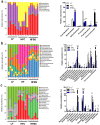Bamboo shoot fiber prevents obesity in mice by modulating the gut microbiota
- PMID: 27599699
- PMCID: PMC5013436
- DOI: 10.1038/srep32953
Bamboo shoot fiber prevents obesity in mice by modulating the gut microbiota
Abstract
Dietary fiber has been shown to prevent high-fat diet induced obesity through modulating the gut microbiota; however, quality difference in fiber type is largely unknown. We performed a 6 week study on C57BL/6J mice fed a macronutrient matched high-fat diet with different fiber types including cellulose (HFC), bamboo shoot fiber (HFBS) and several other commonly consumed fibers. Our results showed that the HFBS group exhibited the lowest weight gain among all diet groups and had improved lipid profiles and glycemic control compared with the HFC group. As revealed by 16S rRNA gene sequencing, loss of diversity in the gut microbiota induced by the HFC diet was largely prevented by the HFBS diet. Moreover, compared with the HFC diet, the HFBS diet resulted in markedly increased relative abundance of Bacteroidetes and strong inhibition of Verrucomicrobia, two divisions strongly correlated with body weight. In conclusion, the present study provides evidence of a quality difference among different types of dietary fibers and shows that bamboo shoot fiber is the most effective in suppressing high-fat diet induced obesity. Our findings indicate that bamboo shoot fiber is a potential prebiotic fiber which modulates the gut microbiota and improves host metabolism.
Figures





References
-
- Schwiertz A. et al. Microbiota and SCFA in lean and overweight healthy subjects. Obesity 18, 190–195 (2010). - PubMed
-
- Barte J. C. et al. Maintenance of weight loss after lifestyle interventions for overweight and obesity, a systematic review. Obes. Rev. 11, 899–906 (2010). - PubMed
-
- Chandalia M. et al. Beneficial effects of high dietary fiber intake in patients with type 2 diabetes mellitus. New Engl. J. Med. 342, 1392–1398 (2000). - PubMed
Publication types
MeSH terms
Substances
LinkOut - more resources
Full Text Sources
Other Literature Sources
Medical
Research Materials

